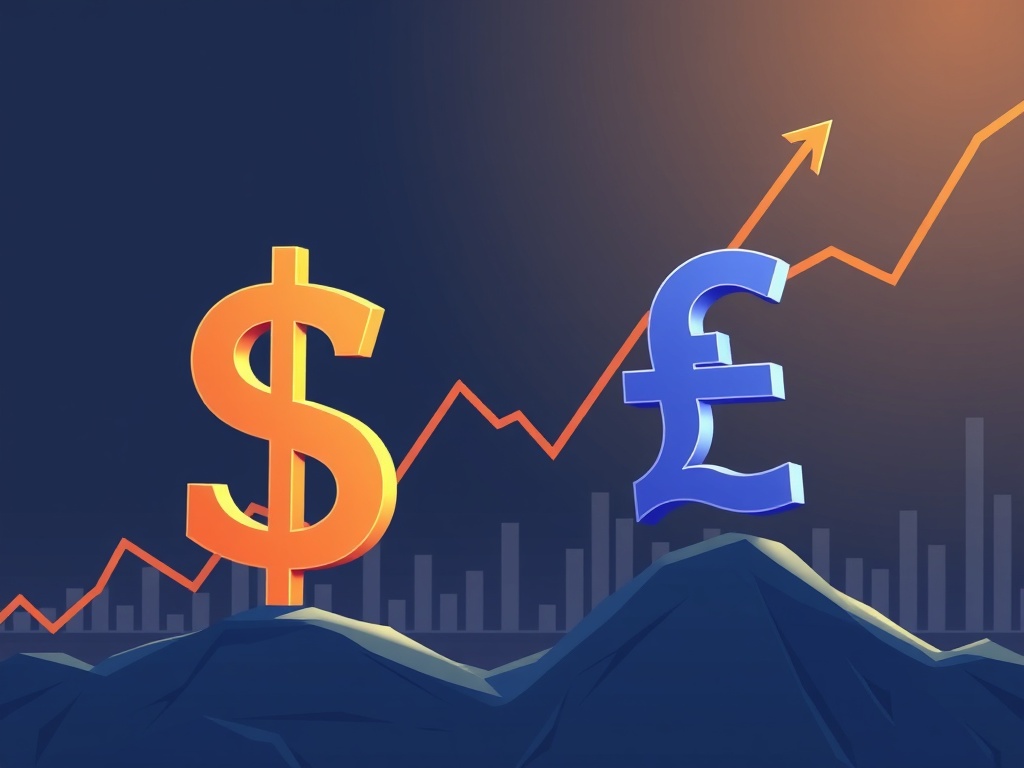BitcoinWorld

US Dollar Rebounds: Sterling Surges on Robust GDP Data
In the fast-paced world of global finance, where traditional markets often set the stage for digital assets, understanding currency movements is paramount. For cryptocurrency enthusiasts and investors, shifts in major fiat currencies like the US Dollar and the British Pound can have ripple effects, influencing risk appetite, capital flows, and ultimately, the valuations of digital assets. Recently, the US Dollar found its footing after a period of noticeable weakness, while the British Pound (Sterling) experienced a significant boost, primarily driven by encouraging GDP data. These developments are not isolated incidents but rather critical indicators of broader economic health and investor sentiment, which can indirectly shape the landscape for Bitcoin, Ethereum, and other cryptocurrencies. Let us delve into the dynamics behind these currency shifts and what they signify for the global financial ecosystem.
Understanding the US Dollar‘s Recent Trajectory
The US Dollar, often regarded as the world’s primary reserve currency and a safe-haven asset, has been on a roller coaster ride. After experiencing a period of considerable weakness, it has now demonstrated signs of steadying. This recent softness was largely attributed to several interconnected factors. Firstly, persistent inflation concerns in the United States, coupled with the Federal Reserve’s cautiously dovish stance on monetary policy, led many investors to believe that interest rates would remain low for an extended period. Lower interest rates typically reduce the attractiveness of a currency to foreign investors seeking yield, thus putting downward pressure on its value.
Secondly, a narrative of global economic recovery, particularly outside the US, encouraged investors to diversify their portfolios away from the dollar and into currencies of economies showing stronger growth prospects. As vaccination efforts progressed globally and various regions began reopening, capital started flowing towards markets perceived to offer higher returns, diminishing the dollar’s appeal as the sole beneficiary of economic growth.
However, the dollar’s recent stabilization suggests a recalibration of market expectations. This steadiness could be a result of shifting sentiment regarding the timing of potential Fed tapering or rate hikes, or perhaps a reassessment of the relative economic strength of the US compared to other major economies. Geopolitical developments and shifts in commodity prices can also play a role in the dollar’s fluctuations. A stable or strengthening dollar can sometimes signal a more cautious risk environment, potentially impacting investor flows into more speculative assets like cryptocurrencies. When the dollar strengthens, it often makes dollar-denominated assets, including some cryptocurrencies, more expensive for international buyers, potentially dampening demand.
Key Factors Influencing US Dollar Movements:
- Monetary Policy: Decisions by the Federal Reserve regarding interest rates and quantitative easing.
- Inflation Data: Consumer Price Index (CPI) and Producer Price Index (PPI) figures.
- Economic Growth: GDP reports, employment data, and manufacturing indices.
- Global Risk Sentiment: The dollar often acts as a safe haven during periods of global uncertainty.
- Trade Balances: The difference between a country’s exports and imports.
How the GBP Exchange Rate Reacted to Economic Signals
In stark contrast to the dollar’s recent struggle for direction, the GBP exchange rate has enjoyed a period of significant strength. This impressive performance can largely be attributed to robust economic signals emanating from the United Kingdom, particularly strong GDP data. The UK economy has shown remarkable resilience and a faster-than-expected recovery trajectory following the impacts of the global health crisis and Brexit-related uncertainties.
The swift and efficient rollout of vaccination programs across the UK played a crucial role in enabling a more rapid reopening of economic activity. This, in turn, fueled consumer spending and business investment, leading to positive surprises in economic indicators. The Bank of England (BoE) has also adopted a relatively hawkish stance compared to some other major central banks, hinting at the possibility of earlier interest rate hikes to combat rising inflation. Higher interest rates make a currency more attractive to foreign investors, driving up demand and its value.
The strong economic recovery narrative has significantly bolstered investor confidence in the UK economy, attracting capital inflows. This increased demand for Sterling has naturally pushed its value higher against major counterparts like the US Dollar and the Euro. For instance, the GBP/USD pair has seen notable gains, reflecting both the dollar’s softness and sterling’s intrinsic strength. This positive momentum in the GBP exchange rate is a testament to the market’s positive assessment of the UK’s economic outlook.
Impact of a Strong GBP:
- Imports become cheaper: Benefiting consumers and businesses reliant on imported goods.
- Exports become more expensive: Potentially challenging for export-oriented industries.
- Increased foreign investment: A stronger currency can attract capital looking for growth opportunities.
- Inflationary pressures: Reduced import costs can help mitigate imported inflation.
The sterling’s performance underscores the profound impact that domestic economic health and central bank policy expectations can have on a currency’s valuation in the international market.
The Critical Role of GDP Data in Currency Valuations
Gross Domestic Product (GDP) is arguably one of the most vital economic indicators, and its influence on currency valuations cannot be overstated. It represents the total monetary value of all finished goods and services produced within a country’s borders in a specific time period. When a country releases stronger-than-expected GDP data, it signals robust economic health and growth, which typically leads to an appreciation of its currency. This is precisely what happened with the British Pound.
Why is GDP so influential? A strong GDP reading suggests a thriving economy, which in turn implies higher corporate profits, increased employment, and potentially, higher interest rates as central banks may tighten monetary policy to curb inflation. All these factors make a country’s assets, including its currency, more attractive to international investors. Conversely, weak GDP data can signal economic contraction or stagnation, deterring investment and leading to currency depreciation.
In the UK’s case, the robust GDP figures provided concrete evidence of a solid economic rebound, dispelling fears of a prolonged downturn and reinforcing confidence in the country’s recovery trajectory. This positive economic surprise directly translated into increased demand for Sterling, as traders and investors positioned themselves to benefit from the UK’s improving economic prospects. Understanding GDP reports is fundamental for anyone participating in or observing the Forex market, as it provides a foundational understanding of a nation’s economic momentum.
Let us look at a hypothetical example illustrating the impact of stronger-than-expected GDP data on a currency:
| Indicator | UK Q1 2023 GDP Growth (QoQ) | Immediate GBP Reaction |
|---|---|---|
| Market Forecast | 0.3% | Anticipated modest appreciation |
| Actual Release | 0.6% | Significant appreciation (e.g., +0.5% against USD within hours) |
This table demonstrates how exceeding market expectations, even by a small margin, can trigger substantial currency movements as traders adjust their positions rapidly.
Navigating the Volatile Forex Market: Strategies for Investors
The Forex market, or foreign exchange market, is the largest and most liquid financial market in the world, with trillions of dollars traded daily. Its sheer size and constant activity make it inherently volatile, influenced by a myriad of factors ranging from economic data releases and central bank pronouncements to geopolitical events and natural disasters. For investors, particularly those in the cryptocurrency space who are accustomed to high volatility, understanding and navigating the Forex market is crucial because it often sets the underlying tone for global liquidity and risk appetite.
The interplay between the US Dollar and the British Pound is just one example of the constant flux within this market. Central bank interest rate differentials, inflation rates, government debt levels, and political stability all contribute to the attractiveness or unattractiveness of a currency. For instance, if the Federal Reserve signals a more hawkish stance than the European Central Bank, the US Dollar is likely to strengthen against the Euro, as investors seek higher yields in dollar-denominated assets.
Challenges in the Forex Market:
- High Volatility: Rapid price swings can lead to significant gains or losses.
- Leverage Risk: Many Forex brokers offer high leverage, amplifying both profits and losses.
- Information Overload: Constant stream of economic data, news, and geopolitical developments.
- Market Manipulation: While regulated, the sheer size can sometimes make it susceptible to large institutional movements.
Actionable Insights for Navigating Forex:
- Stay Informed: Regularly monitor economic calendars for key data releases (GDP, CPI, employment reports) and central bank meetings.
- Understand Correlations: Recognize how major currency pairs move in relation to each other and to other asset classes like commodities or equities.
- Risk Management: Utilize stop-loss orders and appropriate position sizing to protect capital from adverse movements.
- Diversification: While direct Forex trading might not be for everyone, understanding currency dynamics helps in diversifying broader investment portfolios, including crypto assets.
- Observe Global Trends: Major shifts in Forex can signal broader economic health or stress, which can impact risk-on/risk-off sentiment across all markets, including cryptocurrencies.
For crypto investors, a strong US Dollar can sometimes imply a flight to safety, potentially drawing funds away from riskier assets. Conversely, a weaker dollar might make cryptocurrencies more appealing as an alternative store of value or a speculative investment. Keeping an eye on these macro-level currency movements provides valuable context for digital asset performance.
Striving for Currency Stability in a Globalized Economy
The concept of currency stability is highly desirable for nations, businesses, and individuals alike. A stable currency fosters confidence, encourages international trade and investment, and helps in managing inflation. For a nation, a stable currency means predictable import and export costs, making it easier for businesses to plan and operate. It also helps in maintaining purchasing power for its citizens and attracts foreign direct investment, as investors prefer certainty over volatility.
However, achieving and maintaining currency stability in today’s highly interconnected global economy is a complex challenge. Factors such as fluctuating commodity prices, global supply chain disruptions, geopolitical tensions, and divergent monetary policies among major central banks can all contribute to currency volatility. The recent movements of the US Dollar and the British Pound exemplify these dynamics: the dollar’s weakness stemmed from inflation fears and a cautious Fed, while sterling’s strength was rooted in robust economic recovery and a relatively more hawkish central bank.
Central banks play a pivotal role in attempting to manage currency stability through monetary policy tools such as interest rate adjustments, quantitative easing or tightening, and foreign exchange interventions. Their goal is often to balance economic growth with price stability, which directly impacts currency valuations. However, their actions are always a delicate balancing act, as policies aimed at boosting domestic growth might inadvertently weaken the currency, making imports more expensive and potentially fueling inflation.
Challenges to Currency Stability:
- Inflationary Pressures: Erodes purchasing power and currency value.
- Public Debt: High debt levels can undermine investor confidence.
- Geopolitical Events: Wars, political instability, or trade disputes can cause sharp currency depreciation.
- Capital Flight: Rapid outflow of funds from a country due to economic or political concerns.
- Speculative Trading: Large-scale speculative positions can exacerbate currency movements.
For the broader financial system, sustained currency instability can lead to economic crises, make international trade difficult, and increase financial market uncertainty. In this environment, assets like cryptocurrencies, which are often touted as decentralized alternatives to traditional fiat currencies, can sometimes gain traction as a hedge against fiat instability, though they come with their own set of volatility risks. Ultimately, the quest for currency stability remains a central pillar of sound economic management in a globalized world, impacting everything from the price of your morning coffee to the stability of your investment portfolio.
Compelling Summary: Navigating Global Currency Shifts
The recent steadiness of the US Dollar after a period of weakness and the impressive surge of the British Pound, fueled by strong GDP data, highlight the dynamic and interconnected nature of the global Forex market. These movements are not merely abstract financial figures; they reflect underlying economic health, central bank policies, and investor sentiment, all of which have profound implications across financial landscapes, including the burgeoning cryptocurrency space. While the dollar’s trajectory suggests a cautious re-evaluation of US economic prospects, Sterling’s strength underscores the market’s confidence in the UK’s robust recovery. For investors, understanding these macro-level currency shifts is vital. It provides context for broader market trends, informs risk management strategies, and helps in making more informed decisions across various asset classes. The pursuit of currency stability remains a continuous endeavor for nations, critical for trade, investment, and overall economic health. Staying informed about these powerful forces is key to navigating the complex currents of global finance.
To learn more about the latest Forex market trends, explore our article on key developments shaping currency stability and global liquidity.
This post US Dollar Rebounds: Sterling Surges on Robust GDP Data first appeared on BitcoinWorld and is written by Editorial Team





